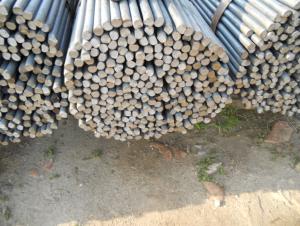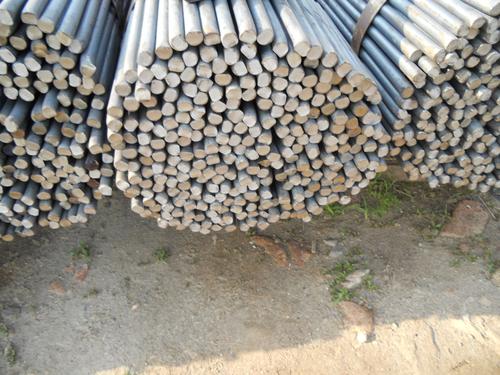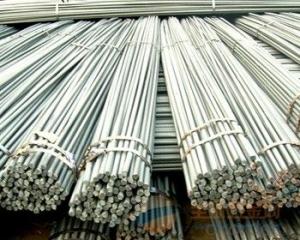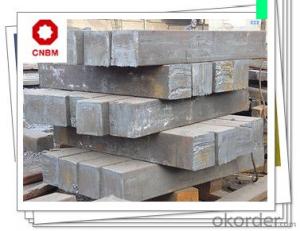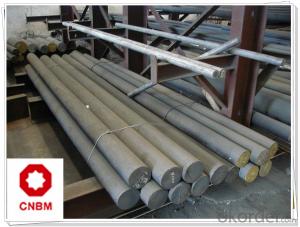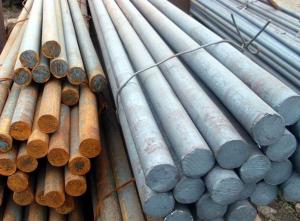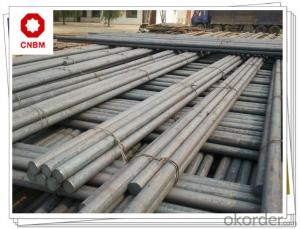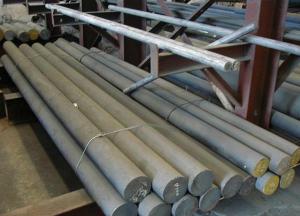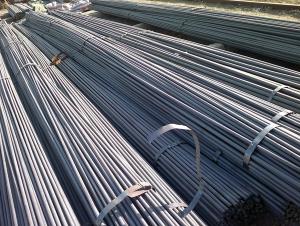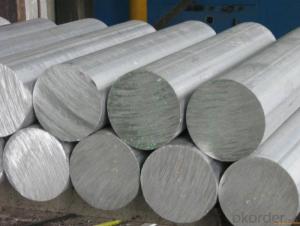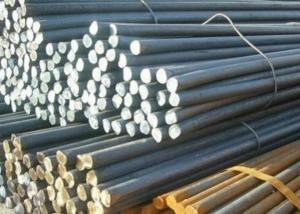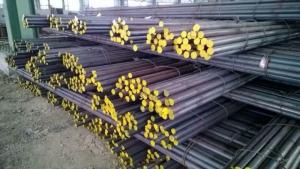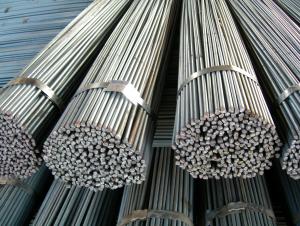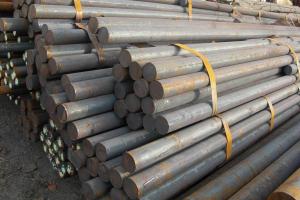Steel Round Bar
- Loading Port:
- China Main Port
- Payment Terms:
- TT OR LC
- Min Order Qty:
- -
- Supply Capability:
- -
OKorder Service Pledge
OKorder Financial Service
You Might Also Like
Specifications of Steel Round Bar:
1. Standard: GB
2. Grade: Q345
3. Invoicing on theoretical weight or actual weight as customer’s request
4. Shape: Round bar, solid bar of steel with circular section
5. Technique: Hot rolled
Size:
| Size (mm) | Section Area (cm2) | Mass (Kg/m) |
| 15 | 176.625 | 1.39 |
| 16 | 200.96 | 1.58 |
Packaging & Delivery of Steel Round Bar:
Packaging Detail: Standard seaworthy packing or as customer required; all goods are packed in bundle with steel strips and shipped by break bulk vessel or container
Delivery Detail: 45 days
Trade terms: FOB, CFR, CIF or as customer required
MOQ: 25 tons per specification; we can negotiate the quantity if the specification is normal or we have stock of one specification.
Weight: The price invoicing on theoretical weight basis or actual weight basis depends on customer’s request.
Shipment: The shipment of bulk break or container is depends on customer’s request.
Documents given: Full set (3/3) of original clean on board bill of lading; Original signed commercial invoice, in 3 originals and 3 copies; Original packing list in 3 originals and 3 copies; Policy of insurance; Certificate of origin and what the target market needs.
* If you would like to get our price, please inform us the size, standard/material and quantity. Thank you very much for your attention.
- Q: Are steel round bars used in the construction industry?
- Yes, steel round bars are commonly used in the construction industry. They are often used as structural elements, such as reinforcement in concrete structures, as well as in the fabrication of various components and fittings.
- Q: Can steel round bars be used in the manufacturing of marine propellers?
- Yes, steel round bars can be used in the manufacturing of marine propellers. Steel is a commonly used material for propellers due to its high strength, durability, and resistance to corrosion in marine environments. By using steel round bars, manufacturers can easily shape and form the propeller blades, ensuring optimal performance and longevity in marine applications.
- Q: What is the difference between a solid steel round bar and a hollow steel round bar?
- A solid steel round bar is a cylindrical metal rod with a consistent diameter along its entire length. It is made of solid steel and does not have any empty space inside. On the other hand, a hollow steel round bar also has a cylindrical shape but contains an empty space within its center. The size of this empty space can vary depending on the design and purpose of the bar. The main difference between the two lies in their structural integrity and weight-bearing capacity. A solid steel round bar offers greater strength and stability compared to a hollow steel round bar. This is because the solid bar is made of continuous steel material, making it more resistant to pressure-induced bending, twisting, or deformations. It is commonly used in industries that require high strength and durability, such as construction, engineering, and manufacturing. In contrast, a hollow steel round bar may have reduced strength and load-bearing capacity due to the empty space inside. However, the hollow design provides certain benefits in terms of weight, cost, and flexibility. The hollow space reduces the overall weight of the bar, making it suitable for applications where weight is a critical factor, such as aerospace or automotive industries. Moreover, the hollow space can be utilized for various purposes, such as passing electrical wires or fluids, providing ventilation, or reducing material costs by using less steel. Ultimately, the choice between a solid steel round bar and a hollow steel round bar depends on the specific requirements of the application. If strength and stability are crucial, a solid bar is the preferred choice. In contrast, if weight reduction, cost-efficiency, or additional functionality is desired, a hollow bar may be more suitable.
- Q: How do you identify the grade of a steel round bar?
- The grade of a steel round bar can be identified through several methods, including visual inspection, markings on the bar, and using specialized testing equipment. Visual inspection involves examining the surface texture, color, and any visible defects or markings on the bar. Markings on the bar often indicate the grade, such as alphanumeric codes or symbols provided by the manufacturer. For accurate identification, specialized testing equipment like spectrometers or hardness testers can be used to analyze the chemical composition and mechanical properties of the steel.
- Q: Can steel round bars be coated with protective coatings?
- Yes, steel round bars can be coated with protective coatings. These coatings serve as a barrier to protect the steel from corrosion, abrasion, and other forms of damage. The most common type of protective coating used on steel round bars is called a corrosion-resistant coating. This coating is typically applied through processes such as hot-dip galvanizing, electroplating, or powder coating. These coatings provide a layer of protection that prevents the steel from coming into contact with corrosive substances, moisture, and other environmental factors that may cause deterioration. Additionally, protective coatings can also enhance the appearance of the steel round bars and increase their lifespan.
- Q: What are the different types of steel round bar alloys for improved toughness and wear resistance?
- There are several different types of steel round bar alloys that are known for improved toughness and wear resistance. Some of these alloys include tool steel, stainless steel, alloy steel, and carbon steel. Each of these alloys has unique properties and compositions that make them suitable for various applications where toughness and wear resistance are crucial.
- Q: What are the different types of steel round bar surface finishes for corrosion resistance?
- There are several different types of steel round bar surface finishes that are commonly used for corrosion resistance. These finishes provide a protective coating on the surface of the bar, preventing contact with corrosive elements and reducing the risk of rusting or degradation over time. One of the most popular finishes for corrosion resistance is hot-dip galvanizing. This involves immersing the steel round bar in a bath of molten zinc, which forms a layer of zinc coating on the surface. The zinc acts as a sacrificial anode, corroding before the steel does, and providing long-lasting protection against rust and corrosion. Another common surface finish for corrosion resistance is stainless steel. This type of steel contains a minimum of 10.5% chromium, which forms a passive oxide layer on the surface when exposed to oxygen. This layer acts as a barrier, preventing further oxidation and corrosion, making stainless steel round bars highly resistant to rust and other forms of corrosion. Electroplating is another method used to provide corrosion resistance to steel round bars. This process involves immersing the bar in an electrolyte solution and passing an electric current through it. This causes a layer of metal, such as zinc or nickel, to be deposited onto the surface of the bar, providing a protective coating. Powder coating is a popular choice for steel round bars that require both corrosion resistance and aesthetic appeal. This process involves applying a dry powder coating to the surface of the bar and then curing it under heat. The powder melts and forms a hard, durable finish that provides excellent corrosion resistance while also offering a wide range of color options. Additionally, there are specialized coatings available for specific applications, such as epoxy coatings or polymer coatings. These coatings are designed to provide superior resistance to certain corrosive environments, such as exposure to chemicals or high humidity. In summary, the different types of steel round bar surface finishes for corrosion resistance include hot-dip galvanizing, stainless steel, electroplating, powder coating, and specialized coatings. Each of these finishes offers varying levels of protection against rust and corrosion, and the choice of finish depends on factors such as the specific application, environmental conditions, and desired aesthetics.
- Q: How are steel round bars tested for quality?
- Steel round bars are tested for quality through various methods such as visual inspection, dimensional checks, surface defects detection, mechanical testing, and chemical analysis. These tests ensure that the steel bars meet the required standards for strength, durability, and composition, ensuring their suitability for specific applications.
- Q: What's the difference between Q345 round steel and No. 45 round steel material?
- Q345: it is a kind of manganese steel (16Mn), yielding strength of 345, good welding performance, commonly used in structural parts welding, low carbon steel, can not be used for quenching or quenching and tempering.No. 45 Steel: high quality carbon structural steel, medium carbon steel. Can be used for quenching or tempering.
- Q: What is the difference between a hot rolled and a precision ground steel round bar?
- The manufacturing processes and resulting surface finishes of a hot rolled steel round bar and a precision ground steel round bar are the primary factors that differentiate them. Hot rolled steel round bars are created by heating the steel billet or ingot to high temperatures and passing it through a series of rollers to achieve the desired shape and size. This method yields a rougher surface finish with visible mill-scale or oxide layers. Additionally, the hot rolling process allows for variations in size and shape, making it a cost-effective choice for producing steel round bars in large quantities. On the other hand, precision ground steel round bars undergo a more refined and controlled manufacturing process. After the initial hot rolling, the bar is ground to achieve a smooth and consistent surface finish. Precision grinding eliminates the mill-scale and oxide layers, resulting in a more polished appearance. This process also ensures tight dimensional tolerance and improved straightness of the round bar. The selection between a hot rolled and a precision ground steel round bar depends on the specific application requirements. Hot rolled round bars are commonly used in applications where surface finish is not crucial, such as structural components, machinery parts, or construction materials. In contrast, precision ground steel round bars are employed in applications that demand a smooth surface finish, precise dimensions, and tight tolerances, such as in the production of precision tools, machinery components, or in industries like aerospace or automotive. In conclusion, the key distinction between a hot rolled and a precision ground steel round bar lies in their manufacturing processes and resulting surface finishes. Hot rolled round bars offer cost-effectiveness and versatility, while precision ground round bars provide a smoother surface finish, tighter tolerances, and improved dimensional accuracy for more demanding applications.
Send your message to us
Steel Round Bar
- Loading Port:
- China Main Port
- Payment Terms:
- TT OR LC
- Min Order Qty:
- -
- Supply Capability:
- -
OKorder Service Pledge
OKorder Financial Service
Similar products
Hot products
Hot Searches
Related keywords
